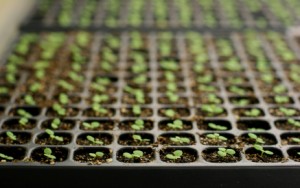Spring should be early this year thanks to some solid predictions by a glutton inspired groundhog.
What do groundhogs love to eat? Virtually anything that grows. And since Nibbles (Asheville’s resident cuddly crop destroyer) did give gardeners a head start, it’s only appropriate that we plant some veggie seeds for her future munching.
Some of the best veggie seeds to start this weekend indoors (and then transplant outside) are broccoli, cabbage, chard, kale, and lettuce. All these seeds are good to start together thanks to the same germination temperature (70 degrees F), as well as having roughly the same date to be put in the outside garden ( early March to early April-check the NC Ag Extension Spring Planting Guide for your region).
Picture from Urban Garden Solutions
Broccoli can be the fussiest of the bunch and requires a little extra planning. Broccoli can be sown directly two months before the last frost, but numerous nights of 30 degrees F and days in the 50-60 degree F range can produce tiny button like heads. Starting inside with controlled temps alleviates this issue. When starting broccoli seed inside, put them in a deeper pot (1′) and either put the pot in a sunny windowsill (remember to rotate the seedling to prevent stretching) or under fluorescent grow light like a T5.
Besides some extra love for the broccoli, the rest of the crew should be easy to sow. Start with a light seed starting mix like McEnroe Premium Lite potting soil, Sunshine Potting Mix, or Light Warrior. You can even add a light fertilizer mix like Happy Frog Jump Start. Spread the mix over a 72 cell tray (a deeper 18 cell for the broccoli). Tamp down lightly and then go ahead and add water before sowing the seeds. This will prevent any runoff from disturbing the seeds.
Next, add three seeds per hole (check seed packet for planting depth). Several seeds per hole is necessary to thin out the weakest seedlings (pinch two of them off when the first set of true leaves–which are the second set–appear). Cover the seed tray with a Humidome, and if your house is cool, place a seedling heat mat underneath to ensure faster germination.
Finally, place your tray under a good grow light or a south facing windowsill. Once the seeds begin to sprout (anywhere from several days to a week), take off the dome. Once a week, you can give the infants a small dosage of seaweed (do a 1/4 to 1/2 strength from the recommended dose on the bottle).
When the seedling mature to a good height (4-6 inches or about 3-4 weeks), you can begin to harden them off outside (as long as temps are relatively nice–60-70 F). Place the plants in the shade for about a week (bringing them inside at night) to get them used to the big bad outdoors. Then, you can begin to acclimate them to the sun.
This is also a good time to start a liquid fertilizer program like Fish hydrolysate or emulsion, which contains both the N-P-K requirements for the plant as well as trace minerals that any plant loves.
Remember, the healthier the plant, the happier (and more rotund) the groundhog.
Stay tuned for transplanting tips…



Leave a Reply